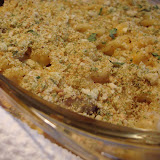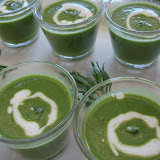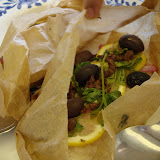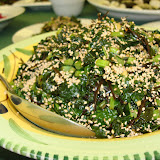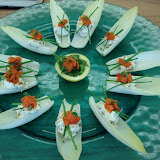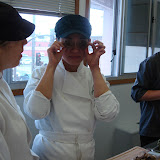Monday, June 29, 2009
Create an Ice Cream Flavor Part 2: Time to vote!
Almond, coconut, chocolate
Peach crumble
Rum raisin
Ginger with caramelized pears and roasted macadamias
Strawberry rhubarb pie
So the poll is now up at the top of my blog! Vote for your favorite flavor for development by Three Twins. Only one vote per person (choose wisely). The poll closes July 6th at 6:00pm, and the winner will be announced shortly after.
Transit Time
With cleanses all the rage, one of the things we talked about was "transit time" -- i.e. how long from in to out. To break it down, what you consume should take about 1 minute in your mouth, 2 - 3 seconds in your esophagus, 2 - 4 hours in your stomach, 1 - 4 hours in your small intestines and 10 hours - 3 days in your large intestines. Of course, certain things take longer than others (and I found this fascinating). How long what you ingest stays "in residence" in your stomach falls into approximately the following rank order:
- Liquids: within a few minutes
- Fruits: 1 - 2 hours
- Veggies: a little longer
- Starches and grain: longer
- Legumes: longer still
- Protein: 3+ hours
- Fat: Longest
In total, transit time should be between 18 and 24 hours ideally. How can you test this? Eat 2 tablespoons of sesame seeds and keep a watch out for when they show back up. See, I warned you it wouldn't be appetizing. I'm going to leave it to other sources to tell you what to do if it takes the little buggers too long to show up... plenty of info out there and I'm not looking to become a specialist.
Friday, June 26, 2009
Recipe: Classic Tomato Gazpacho with Croutons

Classic Gazpacho with Croutons
Gazpacho is typically better the next day, after the flavors meld. For this quick and easy version that tastes good right away, I used bottled tomato juice, plenty of vinegar and a garlic paste to provide an instant flavor base. You can make this gluten-free by substituting gluten-free bread.
Ingredients
Soup:
2 cups peeled and diced (1/4 inch) hothouse cucumber, seeded
2 cups diced (1/4 inch) bell pepper (red, yellow or orange)
2 cups diced (1/4 inch) ripe tomato
1/2 cup diced (1/4 inch) red onion (soaked in water and a bit of vinegar for at least 20 minutes - this makes raw onion much more palatable by removing the strong aftertaste)
2 cups high-quality tomato juice (Knudsen recommended)
1/2 cup red-wine vinegar
1/3 cup extra-virgin olive oil
1/4 cup cilantro, chopped
1 clove garlic
Sea salt and pepper, to taste
Croutons:
3 slices bread, medium diced
4 tablespoons olive oil
Salt to taste
Optional: Seasoned sea salt to rim glass
Directions
1) Preheat oven to 400 degrees. Toss bread with olive oil and salt, spread on baking sheet lined with parchment paper, and place in center of oven. Toast approx. 10 minutes (or until golden brown), turning once. Remove and allow to cool.
2) While croutons toast, place the diced vegetables in a large bowl. Add the tomato juice, vinegar (reserve a few tablespoons), oil and cilantro (reserve a bit for garnish).
3) In a mortar and pestle, mash garlic with salt and 3 croutons. Add to soup mixture.
4) Transfer half of the mixture to a blender and pulse to coarsely puree. Return to the bowl, and stir to combine. Season with salt and pepper and remaining vinegar if needed (it should taste almost spicy from the vinegar, but not be overly acidic).
5) For serving, rim glasses in seasoned salt if desired. Garnish with croutons and cilantro.
Servings: 4 - 6 bowls. Adapted from “Farmstand Gazpacho,” Parade Magazine, June 2008.
Nutritional Information:
Tomatoes – Contain lycopene (a red carotene) that prevents diseases (including cancer and heart disease) by neutralizing harmful oxygen free radicals before they can do damage to cellular structures.
Cucumber – An excellent source of silica, a trace mineral that contributes to connective tissue strength.
Bell peppers – Protective against cataracts (possibly due to vitamin C and beta-carotene). Capsaicin, flavonoids and vitamin C also shown to prevent blood clots and reduce risk of heart attacks and strokes (similar to chili peppers, though not as concentrated).
Tuesday, June 23, 2009
Landmark Meals
1) Ubuntu - This Napa "vegetable" restaurant is drawing raves for it's innovative cuisine, which is vegetarian but doesn't make you feel "deprived." My classmate Shannon raves about their cauliflower dish (of course). I'm lucky to have my Aunt Nancy visiting from NY shortly after my birthday, and we're both looking forward to a meal here. On the train into work this week I came across a review in this month's O Magazine.
2) Final Showcase - As the culmination of our program, my class will be serving up a final showcase meal to which we're each allowed to invite two guests. The planning is already in full force, though it's not until the end of August. More on that in future blog posts, as we essentially attempt to open a restaurant for a night.
3) El Bulli - In Spain, about two hours drive from Barcelona up along the coast by France, El Bulli reigns supreme. Ranked the #1 restaurant in the world for the 4th year in a row, El Bulli gets 1,000,000 res requests/year. Only 8,000 get in -- including my former roomie Dave, whose offer of a seat at his table is like sharing a winning lotto ticket (I pretty much hyperventilated... for about 20 minutes). His reservation is for Monday, October 19th. What could be a more perfect culinary school graduation celebration than a once-in-a-lifetime Foodie Mecca pilgrimage?
If anyone has been to Ubuntu or El Bulli, I'd love to hear about it!
Monday, June 22, 2009
Recipe: Pad Thai
Ingredients
1 package Pad Thai rice noodles
½ cup tamarind juice (if you buy paste, mix it with warm water to reconstitute)
¼ cup palm sugar
½ cup fish sauce
1 tsp chili powder
2 Tbs coconut oil
2 shallots, minced
4 cloves garlic, minced
2 eggs, beaten
2 cups bean sprouts
3 scallions, thinly sliced
¼ cup peanuts, chopped
1 small bunch cilantro, chopped
2 limes, sliced
Procedure
1 Soak the dry noodles in lukewarm water for 15-20 minutes, until flexible but not soft. Drain and set aside. In the meantime, prepare the rest of the ingredients.
2 In a small saucepan on medium heat, add the tamarind juice, palm sugar, fish sauce, and chili powder. Bring to a simmer until the palm sugar dissolves. Turn off heat and set aside.
3 Have all of your ingredients organized next to the stove. Heat a wok on medium-high heat until hot. Add the coconut oil and immediately add the shallot and garlic stir until they start to brown but make sure they don't burn. Add the noodles to
the wok. Stir quickly to keep things from sticking. Add tamarind mixture and stir until the liquid evaporates. If it still seems a little dry, add some water. Make room for the egg by pushing all noodles to the side of the wok. Pour the egg into
the wok and scramble it until it is almost all cooked. Fold the egg into the noodles. Add the bean sprouts and scallions. Stir a few more times. The noodles should be soft and tangled at this point.
4 Pour onto the serving plate and sprinkle with peanuts and cilantro. Garnish with sliced lime.
(source: Bauman College Staff)
Tuesday, June 16, 2009
Three Stone Hearth Fieldtrip - Intro to Weston Price and CSKs
 Ever heard of a Community Supported Kitchen (CSK)? I hadn't until this Tuesday, when we went to visit the one called Three Stone Hearth in Berkeley, CA.
Ever heard of a Community Supported Kitchen (CSK)? I hadn't until this Tuesday, when we went to visit the one called Three Stone Hearth in Berkeley, CA.What is a CSK? It builds off of a growing trend in community-supported food suppliers, though the more commonly known version is a CSA, or Community Support Agriculture. The website LocalHarvest provides a handy central resource for anyone looking for more info on CSAs, which they define as:
...a popular way for consumers to buy local, seasonal food directly from a farmer. Here are the basics: a farmer offers a certain number of "shares" to the public. Typically the share consists of a box of vegetables, but other farm products may be included. Interested consumers purchase a share (aka a "membership" or a "subscription") and in return receive a box (bag, basket) of seasonal produce each week throughout the farming season.
With its history of generating new food movements (a la Chez Panisse), it's not surprising Berkeley also served as the birthplace for Three Stone, which I was told was the one and only CSK, but it looks like they have competition (though not really, since this one's in Portland).
We were given a background talk on Three Stone, toured the facilities, and spent four hours helping in the kitchen. To add to its one-of-a-kind vibe, Three Stone is in the cavernous space that previously housed my favorite Thai grocery store, Tuk Tuk (as in the mini-bus like vehicle used in Thailand). Half the space is still filled with Thai groceries and an actual Tuk Tuk bus. The other half is Three Stone Hearth, buzzing with music and volunteers, and saturated with slow-cooked, nutrient-rich food scents.
Our field trip also introduced us to Dr. Weston A. Price. Ever heard of him? Don't feel bad if you haven't, just like a CSK, I was clueless about this diet guru, called the "Charles Darwin of Nutrition." A Cleveland dentist in the early 1900s, Price traveled the world studying isolated human groups showing healthier traits and observing their diets in a quest to understand the causes of physical degeneration (including dental decay). Three Stone Hearth "follows the guidelines for human nutrition that were developed and discovered by indigenous and traditional peoples around the world and recorded by Dr. Weston A. Price." Among the guidelines Price set forward which you can learn more about at their website:
- Nutrient density
- Liberal use of traditional fats
- Raw and cultured dairy products
- Whole grains that have been soaked, sprouted, soured or naturally leavened
- Use of natural and unrefined sweeteners only, balanced by fats and proteins or lacto-fermented
- Animal products from pastured livestock
- Avoidance as much as possible of processed and chemical ingredients and toxic substances
None of these guidelines seem revolutionary. If we weren't all eating so much processed food of uncertain origins, we wouldn't need constant reminders of what "real" wholesome food is. But regardless, it's clear that Three Stone's food is high quality, and that they are extremely careful about sourcing ingredients. We were told some customers use them as a stepping stone from eating vegetarian back to eating animal protein, because they can be reassured Three Stone's meat is of the best quality. For individuals who want delicious, wholesome prepared foods but don't cook, I could also see Three Stone being a good option. Or for someone who's ill and looking for food at its most nourishing.
Three Stone does a weekly menu. My favorite thing was the Meaty Pint... exactly as it sounds, a delectable pint of extremely meaty stew. In our case, it had tons of chicken sp
Thursday, June 11, 2009
Hidden Sugar
 I’ve been consuming sugar unwittingly at every step, even as I try not to. Even at dinner last night in my entrée. Though I’m trying my best to stay away from the stuff since it’s unhealthy and makes me feel awful, it’s nearly impossible because it’s being hidden everywhere. I was so disgusted when I dug into my first mouthful of chicken stir fry last night at a local Thai restaurant and realized it was sugared that I decided to do some research and make the topic of hidden sugar my next blog post. I’m not dogmatic, so this is not to say you should never eat sugar. A little is normal (sugar does occur naturally and its unrefined form doesn’t impact your body as much). But my point is that it shouldn’t be so difficult to avoid, especially when it’s hidden in foods you wouldn’t even want it in.
I’ve been consuming sugar unwittingly at every step, even as I try not to. Even at dinner last night in my entrée. Though I’m trying my best to stay away from the stuff since it’s unhealthy and makes me feel awful, it’s nearly impossible because it’s being hidden everywhere. I was so disgusted when I dug into my first mouthful of chicken stir fry last night at a local Thai restaurant and realized it was sugared that I decided to do some research and make the topic of hidden sugar my next blog post. I’m not dogmatic, so this is not to say you should never eat sugar. A little is normal (sugar does occur naturally and its unrefined form doesn’t impact your body as much). But my point is that it shouldn’t be so difficult to avoid, especially when it’s hidden in foods you wouldn’t even want it in.- One in 3 Americans born after 2000 will contract early-onset diabetes, according to research cited in Food Inc. (opening in theaters Friday, review here).
- Prior to the turn of the century, the average consumption was only 5 lbs per person per year.
- According to the same site that provided the stat above, in the past 20 years, Americans have increased sugar consumption from 26lbs to 135lbs per person per year (I saw numbers as high as 170lbs per person per year elsewhere).
That’s a phenomenal accomplishment, and one that’s making a lot of us sick without even realizing it.
Where is sugar being hidden?
For my Thai dinner, I tried to order healthy – a green bean salad and stir fry in a spicy basil sauce. All was well until I tasted the stir fry and realized it was suspiciously sweet. Then my mind went back to our native Thai classmate Komoot saying Thai restaurants here add sugar. I asked my waitress whether there was added sugar. Sure enough. There was. Who would think to say “No sugar please” when ordering a chicken entree? So word to wise, when you go out for Thai, request no sugar (you should also request no MSG, but that’s a whole other story).
And beyond sneaky sugar in restaurant dishes is another other level of treachery from those who profit from the consumption of sugar. For the food industry, sugar is cheap to produce, and the cheaper the calorie, the bigger the profit margin, so they try to slip more and more of it past us. One way to do this is by including multiple forms of sugar in a single food. Since food labeling practices specify listing ingredients in order of amount, if the “sugar” is divided into multiple varieties, all of a sudden it drops down the list lurking in pseudonyms. It may still be the first or second ingredient, but it’s much harder to tell that what you’re eating is almost all sugar.
If you see these on a label, you’re eating sugar:
- Cane juice, caramel, barley malt, ethyl maltol, maltodextrin, maltose, mannitol, sorbitol, refiner's syrup, all fruit juice concentrates (including grape, apple, pear juices), all “ose” (including dextrose, fructose, lactose, galactose, glucose, maltose and sucrose), the “corns” (corn sweetener, corn syrup, high-fructose corn syrup) honey, invert sugar, syrups
 (malt, maple, rice, sorghum), molasses, raw sugar, turbinado sugar, brown sugar, white sugar, yellow sugar, beet sugar, and of course just plain sugar.
(malt, maple, rice, sorghum), molasses, raw sugar, turbinado sugar, brown sugar, white sugar, yellow sugar, beet sugar, and of course just plain sugar.
Places to be especially aware of hidden sugar:
- Cereals (duh), baby foods, nut butters, bread, spaghetti sauce, nutrition bars, "health" drinks, microwave meals, sauces (especially ketchup and bbq), salad dressings, restaurant food (especially fast food and ethnic cuisines that use sweet and spicy flavors like Thai) and yogurts.
Why is sugar bad anyways?
- Contributes to weight gain/diabeties: In our image conscience society, you would think more people would realize that sugar leads to weight gain. Sugar is purely empty calories – no nutritional value whatsoever. Nada. Zero. Zilch. Even fat in certain forms is healthy and should be consumed to keep your body functioning properly (those who aren’t getting enough fat can actually show signs of diminished ability to process thoughts, i.e. early senility). Yet, “low fat” products often take out the fat and up the salt and sugar in its place. They don’t actually satiate appetite without fat, so you consume more, and in the process you get all those lovely empty sugar calories that turn into fat anyways. Good times, huh? It’s one thing to put on a few extra pounds, but we’re not only talking superficial appearances here. Overconsumption of sugar contributes to both obesity and diabetes, which can be deadly. And as I already mentioned, one in 3 Americans born after 2000 will contract early-onset diabetes.
- Makes you feel gross: That initial sugar rush may be fun, but after you’re probably not gonna feel so hot. Sugar can contribute to hyperactivity, anxiety, depression, concentration difficulties and crankiness. These things are especially pronounced in children.
- And the list goes on: Sugar also suppresses the immune system, elevates harmful cholesterol levels, can cause hypoglycemia, causes toxemia during pregnancy, headaches (including migraines), increased risk of blood clots and strokes, kidney and liver damage, increased risk of heart disease, tooth decay and inhibited absorption of minerals such as calcium.
Where can I learn more?
See Food Inc. -- An eye-opening film about the workings of our food industry and its affects on American's diets, including sugar consumption.
Some helpful online reading:
http://www.healingdaily.com/detoxification-diet/sugar.htm
http://yourtotalhealth.ivillage.com/finding-hidden-sugar.html
Wednesday, June 10, 2009
Shout out to Kasey
Everyone misses you and wishes you a speedy recovery Kasey! We're a bit lost without you (seriously, you should have seen us trying to figure out who had what clean up task last class, of course no one would admit to it being their turn at washing dishes).
Everything I ever needed to know I learned as a catering intern
"...only 7.4 million out of the 133 million blogs the company tracks had been updated in the past 120 days. That translates to 95 percent of blogs being essentially abandoned, left to lie fallow on the Web, where they become public remnants of a dream — or at least an ambition — unfulfilled."
After a crazy week, I can understand how this happens. With visitors from Israel, midterms and my former roommate's wedding, something had to give, and that thing was the blog (and sleep). This morning I woke up rested (finally) and ready to write. I love to write, I love to cook, and I will continue to blog damn it. So here's a catch-up blog on my catering adventure.
Everything I ever needed to know I learned as a catering intern:
From assisting Back to Earth at a recent wedding
- Sharpen your knives: The chefs sharpened their knives between almost every task -- at least three times over the course of four hours cooking. This was the most eye opening thing to me. We know it's important to sharpen our knives. But somehow the act is intimidating. As if running the blade is going to send off sparks that will burn down the house, you'll injure yourself, or you'll ruin your knives. Most people use knives until they are dull remnants of the former selves. Some take them to farmers market sharpeners. Some try to tackle the job at home. But here's the honest truth: sharpening knives is neither difficult nor expensive. Really. I bought a $30 diamond sharpening steel and have been using it to great success. Ask a local kitchen store which sharpener is right for your knives (there are different needs for German knives vs. Japanese, etc). They may demonstrate for you, or look it up sharpening basics online. But you should be sharpening your knives almost daily, depending on how much you cook.
- Less is more: Simple is a buzz word lately. Think "Real Simple" the magazine, and everyone's desire to get "back to the basics." In cooking it can be difficult to keep things simple, but the truth is you don't really need that much equipment or complicated ingredients. We worked with five of us in a tiny outdoor kitchen on dishes that had a limited list of ingredients, but in which each ingredient was the very best quality possible, and the end result was the best catered food I've ever tasted.
- Don't do a hack job: I was given bunches and bunches of parsley and basil to chop. Having always seen people run a knife over herbs repeatedly, I started going at it. One of the chefs was kind enough to show me that with herbs, no matter how small, you need to have your (very well sharpened) knife slide through to make a clean cut as you hold the herbs bunched with your hand. Do not go back over them repeatedly on the cutting board with your knife. This makes them turn color and become bitter, and negatively impacts the flavor of your dish.
- Do cut the cheese: Or to be more polite, think of how to make the guest feel comfortable. I was surprised to see one of the chefs cutting a wedge into each oversize block of cheese on a gourmet cheese board until he explained that this made everyone more likely to dig right in. I thought this was a brilliant party tip.
Okay, so maybe this isn't everything I ever needed to know. But it was a phenomenal experience learning some cooking basics that go way beyond classroom knowledge.
Friday, June 5, 2009
Hallelujah! Midterm Secret Ingredients Answer My Prayers
My surprise challenge was to use the following:
Cherries, sweet potatoes, kale (ingredients)
Battonet, braise, cast iron skillet (method/equipment)
We spent time up front brainstorming. I sketched out a menu of two different galetes: one savory and one sweet, as well as fries (those would tick off my sweet potatoes, battonet knife cut and use of the cast iron skillet). From there, we had 90 minutes in the kitchen, along with our sous chefs, to make everything. I'm forever in debt to Shannon for pulling off the perfect galette pastry. Though I wrote out the specs, it was her implementation. As she worked on making the dough and rolling the mini pies out, I created fillings, and hacked up the darn potatoes, then fried and spiced them.
My final menu:
--Sweet galette, cherries macerated in cinnamon, almond extract, a sprinkling of sea salt, succanat (alternative sweetener) and arrowroot (to thicken). Garnished with pistachios.
--Savory galette, "mini pizzas" with tomato sauce, braised leeks and kale with garlic and oregano. Garnished with cheese topping and oregano.
--Marscapone and goat cheese combined as topping for both. This was a nice way to "bridge" the concept together.
--Sweet potato fries with garlic chili salt.
Unfortunately I forgot my camera, but should have photos thanks to my classmate Lara to post later.
Thursday, June 4, 2009
Midterms! Go Team ShoShan
Luckily, I have a rock star sous chef, Cauliflower Queen Shannon herself. She's dubbed us "Team ShoShan." My fingers are crossed that one of the ingredients we get is the stone fruit that's in season. I have a baking project I'd love to use them for, but who knows what's in the cards! I will post a complete report along with photos of our creations, though it likely not until next week since I'm off to LA this weekend for my roommate's wedding.

